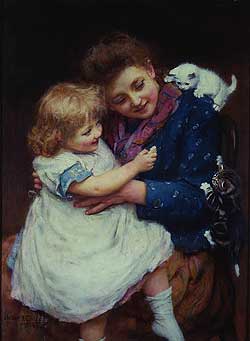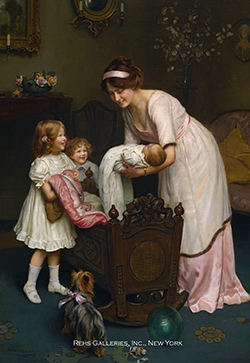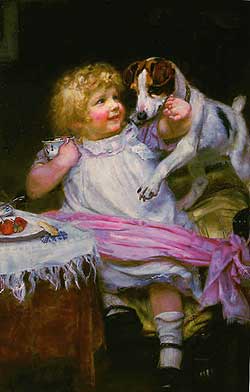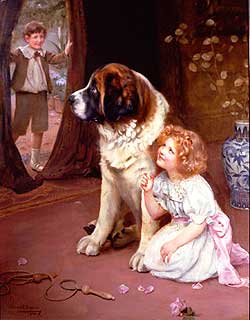Arthur John Elsley - Victorian Childhood
During the middle of the nineteenth century, genre paintings with domestic life subjects became popular in England. The new affluent middle class favored particular genre paintings that depicted children with their pets in playful settings. Arthur John Elsley was one of the most popular English artists who depicted childhood scenes in the late Victorian and Edwardian periods. His paintings were so popular during his lifetime that many were reproduced as prints and often used in calendars, advertisements, books, and magazines.
Arthur John Elsley was born on November 20, 1860, in London, England. He was one of six children born to John Elsley and Emily née Freer. His father was a coachman, and an amateur artist, who had exhibited a painting entitled A Group of Horses at the British Institution Exhibition in 1845. However, around 1872, John Elsley was afflicted with fibroid phthisis, which forced him to retire as a coachman and take the position of resident caretaker for a firm of stockbrokers in London.
The earliest surviving drawing of Arthur Elsley was created when he was eleven years old. It was a pencil sketch of a cairn terrier named Vic. Other works included pencil sketches of a chimpanzee, a giraffe, and an arctic wolf, which he made when visiting the Zoological Gardens in Regent's Park in 1874. By the time he was fourteen years old, Elsley had enrolled in South Kensington School of Art, which later became the Royal College of Art. Around that time, he contracted measles, which caused permanent damage to his eyesight. (Terry Parker, Golden Hours, The Paintings of Arthur J. Elsley, 1860-1952, p. 7)
In 1876, Elsley became a probationer at the Royal Academy Schools, where he studied there under Frederick Pickersgill (1820-1900, Keeper of the Royal Academy between 1873 and 1887), Edward Armitage (1817-1896, Professor of Painting 1875-1882), John Marshal (d.1896, Professor of Anatomy 1873-1890), and Henry Bowler (1824-1903, Professor of Perspective between 1861 and 1899). An avid cyclist, Elsley used to take off to the countryside on his bicycle to get inspiration for his compositions. In 1878 he exhibited his first painting at the Royal Academy - A Portrait of An Old Pony; this was the only one his father would see, as he died one month later.
Elsley continued to study at the Academy Schools until 1881-1882. He then began to earn his living from portrait commissions of children, horses, and dogs. During that time, he exhibited mostly domestic equestrian paintings. In addition, he painted numerous family and canine portraits for the Benett-Stanford family, who lived at Preston Manor. Many of these works are still on display at the Manor, which is open to the public. In 1885, when he was just 24, his line drawing titled April Floods in Eastern Countries was published in a boy's magazine (Young England in 1885, No. 43, April 1885). This work was a line engraving entitled April Floods In Eastern Counties.
Elsley was well acquainted with other British artists such as Solomon Joseph Solomon (1860-1927) and George Grenville Manton (1855-1932), with whom he began sharing a studio in 1886. Manton introduced Elsley to Frederick Morgan (1847-1927), the then-popular genre painter specializing in scenes of children playing. When Manton left the studio in 1889, Elsley moved into Morgan's studio, which was mutually beneficial. Morgan was already an established figurative artist but could not paint animals and had collaborated in the past with a specialist in canine portraits, a role that Elsley would now take over.
In 1891, Elsley won a silver medal in the Crystal Palace exhibition for his painting entitled The Bailiff's (sic) Daughter of Islington. The following year, his painting I'se Biggest (1892) was reproduced as a print, and it became so popular it had to be re-engraved. That scene of a little girl measuring her height against a St. Bernard dog was described as "one of those simple and unaffected pictures which readily lend themselves to reproduction and has so much nature and so admirable a touch of humor in it that no doubt a great number of those who admire it at Burlington House will be delighted to have an opportunity of hanging a version of it upon their walls," (Parker, p. 20). Also, in 1892, The Illustrated London News, a popular weekly magazine, chose one of Elsley's paintings, Grandfather's Pet (1892), as their 1893 Christmas print.
The success which Elsley began to enjoy enabled him to have the financial means to marry his second cousin Emily (Emm) Fusedale on November 11, 1893. She was ten years his junior and had modeled for him for ten years. They would have one child, Marjorie, born in 1903, who would become the model for many of his successful paintings. After his marriage, Elsley moved to his own studio, but "the interplay of ideas and compositions with the use of the same models" showed a continued cooperation with Morgan. (Parker, p. 9)
In 1894, when the well-known artist Charles Burton Barber (1845-1894) died, Elsley succeeded him as the foremost exponent of paintings depicting children and pets. The Illustrated London News, January 25, 1896, (p.120) wrote:
"Mr. Elsley appears more distinctly as a follower, though not an imitator, of Mr. Burton Barber, differing from him by allowing his children more than a pet at a time, and going beyond the limitations of a fox-terrier, or a collie. He has a keen sense of humor, especially in his treatment of puppies' backs, which, as students of dog-life well know, are their most expressive features." (Parker, p. 10)
Around the turn of the century, Elsley and Morgan became permanently estranged when Morgan accused him of stealing one of his ideas. (Parker, p. 11) Elsley started to produce more "adventurous, multi-figured works on a grander scale." (Parker, p.11) These paintings were developed in his studio. The children and animal models sat individually, and outdoor elements were from oil sketches he made of landscapes, photographs, or images of countryside panoramas in Country Life magazine. This method of working in his studio may have accounted for "some of Elsley's problems with perspective, not helped by his short-sightedness which sometimes caused him to use opera glasses to see his models!" (Parker, p. 11)
The First World War affected Elsley's productivity. During that period, he worked part-time at a munitions factory, where he "filed the jigs used to test gun-sights in the making." (Parker, p.11) As the work put additional strain on his eyes, he only painted four pieces from 1915 to 1917. Three were commercial works, and one was a portrait of his daughter Marjorie, which was not for sale but exhibited at the Royal Academy. He continued to paint mostly for pleasure in the years that followed and exhibited some of his works until 1927. However, his eyesight continued to fail, and by 1931 it became so poor that he confined his activities to woodwork, metalwork, and gardening. Arthur John Elsley died at his home on February 19, 1952, at the age of 91.
During his career, Arthur Elsley exhibited 52 works at the Royal Academy from 1878 until 1927 and many more at other major exhibition halls throughout England. These included: The Royal Society of British Artists, London; The Walker Art Gallery, Liverpool; The Institute of Painters in Oil Colors, London; French Gallery, London; Dudley Gallery, London; The Institute of Fine Art, Glasgow; Manchester City Art Gallery; The Royal Society of Artists, Birmingham; Nottingham, Castle Museum; Victoria Gallery, Bath; The Crystal Palace, London; Cork International Exhibition.
Throughout his career, his paintings were used for commercial purposes. Among the firms were Thomas D. Murphy Co.; Sunlight Soap; Old Calabar Dog & Puppy Biscuits; Brooks Sewing Cotton; Peek, Frean & Co.; Biscuits & Cake; and a cover for the publication of Bibby's Quarterly.
His works are in several museum collections, including the Russell-Cotes Art Gallery and Museum, East Cliff, Bournemouth; Hartlepool Museum Services, Sir William Grey House, Clarence Road, Hartlepool; Lady Lever Art Gallery, Port Sunlight, Liverpool; The Royal Liverpool Children's Hospital, Liverpool; Royal Pavilion Art Gallery and Museum, Brighton and Preston Manor, Brighton.
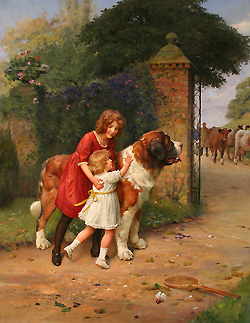 Arthur J. Elsley (1860 - 1952) Safely Guarded 31 1/2 x 24 1/2 inches Signed and dated 1924 SOLD Request More Info |
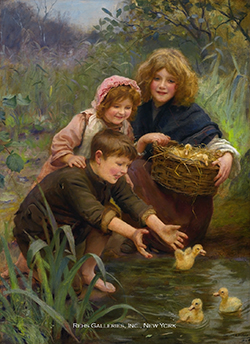 Arthur J. Elsley (1860 - 1952) Learning to Swim 34 3/4 x 25 1/2 inches Signed & dated 1904 SOLD Request More Info |
||
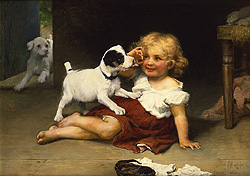 Arthur J Elsley / Frederick Morgan Ruff Play 26 x 36 inches Signed by both Arthur J. Elsley & Fred Morgan SOLD Request More Info |


